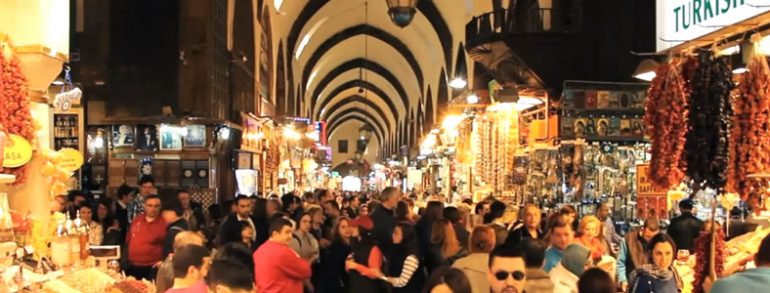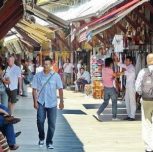One of the oldest covered bazaars in İstanbul, the Egyptian Bazaar is located in the Eminönü district of İstanbul, behind New Mosque and adjacent to the Flower Market. Continuing its existence since 17th century, the Egyptian Bazaar originated from the Makron Envolos Bazaar which was located in the same place in Byzantine times. The Venetian and Genoese people were doing business in that bazaar. The Jew people were also residing in the same area during Ottoman times. Along with the construction of New Mosque, the Jew people in Eminönü were transferred to Balat district.
The Egyptian Bazaar was indeed founded with the intention of monetary assistance to New Mosque during its construction. Initiated by Safiye Sultan, mother of Sultan Murat III., in 10 Muharram 1006 (1957), the construction was completed by Hatice Turhan Sultan, mother of Sultan Murat IV., after a long period of stagnation. The architects were Davut Aga and Mustafa Aga.
The Egyptian Bazaar building used to be utilized as madrasa in its early days. Following the uprising of the residing mullahs, the madrasa was converted to bazaar. Formerly known as the Valide Bazaar, it later earned reputation with the name of Egyptian Bazaar as the spices that were sold in the bazaar were coming from Egypt.
Converted to bazaar, the building was allocated between herbalists and cotton dealers. 3 (Fish Bazaar, Mat and Linen Dealers) of the 6 gates were allocated to herbalists; and the rest (New Mosque, Haseki and Flower Market) to the cotton dealers.
The shops allocated to herbalists were consisting of two sections. While retail sale and presentation of spice containers were made in the wooden front section, the back section was used for storing and manufacturing purposes. The wooden pull-down shutters used to be taken down at nights after closure. The space in front of the shops used be prinked up with wooden ornaments; and the spices be stored in glass jars, earthenware pots, wooden or tin cans of various shapes. In the eaves of some shops, there used to be a symbol (fire tower, a little boat, ostrich egg, scissors, tassel and etc.) to get easily recognized. With the assistance of those symbols, people could easily find the intended shop and give directions to others.
No matter how much the outlook may have changed in time, the Egyptian Bazaar still continues its existence as a valuable cultural heritage from the Ottoman Empire at the present time. Having two great fires respectively in 1691 and 1940 and been restored by the İstanbul Metropolitan Municipality in 1943, the Egyptian Bazaar mostly comprises of herbalists and spice stores even if new jewelry stores have started to show up recently. At the same time, the stores which sell snacks and appetizers, dried nuts and fruits, plants, healing herbs, olives, dried fruit roll-ups, handcrafts and wearing apparels can also be found within the bazaar. Aimed at the ones who cannot put up with the diversion in “flavor and taste” caused by industrialization, “farm-made” or “farm-originating” cheeses, pastirma types – wind-dried beef –, sujuk and legumes are also exclusively offered in the bazaar. And the Egyptian Bazaar does not seem to be eager to lose this traditional characteristic anytime soon.
Outside of the Egyptian Bazaar, greengrocers, snack and appetizer stores and fish stores are located on the west; and flower markets and pet stores on the east. From any kind of aquarium fish to the flower seeds that you can only find in the pages of an encyclopedia, one can find almost anything that he or she is looking for. The Egyptian Bazaar is in the service of İstanbul people seven days a week.









